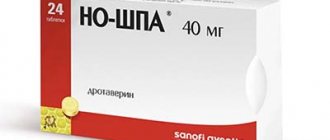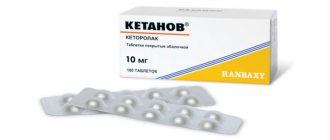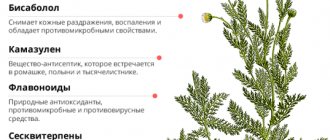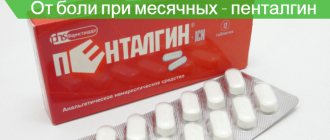Menstruation is a regular process in which a woman sheds the endometrium and releases it along with blood through the genital tract. This is often accompanied by unpleasant symptoms, the most common of which are pain in the lower abdomen and/or lower back. According to statistics, about 65% of the fair sex know about this problem firsthand.
The approach to solving this problem may be different, but most women prefer to endure temporary discomfort. At the same time, gynecologists say that doing this is dangerous. The fact is that pain is a strong stress factor and can lead to serious consequences for the entire body.
Causes
Before using this or that pain reliever, you need to understand why your stomach hurts during menstruation. Pain in the lower abdomen and/or lower back during menstruation is usually associated with active contraction of the maca during this period. This process is necessary for the complete rejection of the endometrium - the inner layer of the uterus.
In addition, during menstruation, a large amount of mucus and blood collects in the reproductive organ, so it swells. Hormonal surges during this period can lead to the accumulation of excess fluid in the body, dizziness and mood swings. During menstruation, it is very important to avoid mental and physical stress, as well as the negative effects of cold.
Pain during menstruation can always accompany a woman, starting from the moment she has her first menstruation. In this case, doctors diagnose primary algodismenorrhea. Among the main reasons for its occurrence are a low pain threshold, disturbances in the structure of the reproductive organs and a deficiency of nutrients in the body (it can occur due to errors in nutrition or the presence of certain pathologies of the gastrointestinal tract).
In the case when a woman first encountered pain during menstruation after many normal, painless menstruation, doctors usually diagnose the secondary nature of the pathology. If we talk about why the stomach hurts during menstruation, then the cause in this case may be adhesions, cystic formations, endometrial hyperplasia, inflammatory processes in the pelvis (endometritis, adnexitis) and many other organic changes in the genitals.
Despite the fact that it is not recommended to endure pain during menstruation, you should also not abuse painkillers in this situation. It is very important that a woman facing this problem consult a doctor in time and undergo a thorough medical examination.
The fact is that painkillers only relieve an unpleasant symptom, but they do not treat the underlying pathology and it continues to progress. If necessary, the gynecologist will tell you which pills to take for menstrual pain and select the ideal treatment regimen for the underlying pathology.
Where does it come from
Doctors believe that hormonal disorders are mostly to blame for the appearance of abdominal pain during menstrual periods. It is the substances progesterone and estrogen produced by the body, as well as FSH and others, that regulate the process of menstruation in general. This is a fairly harmless reason when it comes to a minor glitch. More serious ailments that provoke severe cramps during menstruation are:
- Problems of the urinary organs;
- Bend or underdevelopment of the uterus;
- Inflammatory gynecological diseases, adhesions;
- Tumors, cysts of female organs;
- Endometriosis.
No-shpa
To eliminate pain during menstruation associated with cramps, doctors recommend taking an antispasmodic. These, first of all, include No-shpu.
This medicine contains the active substance drotaverine hydrochloride. The medicine is available in the form of a solution for injection, as well as in tablet form. If during menstruation you feel pain in your lower back or stomach, the latter option is preferable to use.
No-spa dilates blood vessels, reduces muscle tone and reduces the sensitivity of internal organs. The advantages of No-shpa also include the fact that it does not have a negative effect on the central nervous system.
Unfortunately, this drug, like many others, has its side effects. These include:
- tachycardia;
- increase in body temperature;
- excessive sweating;
- dizziness;
- decreased blood pressure;
- allergic reactions;
- headache;
- urge to vomit;
- constipation.
Despite the presence of an extensive list of possible complications, patients who used No-shpa during menstruation write mostly positive reviews about it. This is explained by the fact that these side effects occur extremely rarely, and the effectiveness of the drug is very high.
If a woman decides to take No-shpa for menstrual pain, how many tablets she needs, she must calculate as accurately as possible.
In general, the dosage of No-shpa for painful periods is 120-240 mg per day. This dose must be divided and taken 2-3 times. In this case, a single dose should not exceed 80 mg. However, if a woman has low body weight, she may take less of the medicine.
Exceeding the dosage is highly undesirable. Extra pills for menstrual pain will not only not increase the positive effect, but, on the contrary, can lead to undesirable consequences, the most severe of which is cardiac arrest.
No-spa during menstruation is contraindicated in patients who have a history of:
- hypersensitivity to the components of the drug;
- advanced form of heart failure;
- galactose intolerance;
- liver and/or kidney failure;
- hypertension.
Ibuprofen
Ibuprofen is another effective medicine for relieving pain during menstruation. It is more suitable for treating mild to moderate discomfort.
If menstrual pain is severe, the drug may not be effective. As practice shows, Ibuprofen gives the best results in the treatment of patients whose menstrual pain in the lower abdomen is caused by an inflammatory process in the pelvis.
This drug contains the active substance ibuprofen. It also contains auxiliary components.
For menstrual pain, Ibuprofen tablets should be taken whole, without chewing. It is very important to drink them with plenty of water. This will help achieve maximum effectiveness of the drug. To relieve pain during menstruation, gynecologists recommend taking Ibuprofen 1 tablet (200 mg) 4 times a day.
It is important to understand that this medicine does not have an immediate effect. A noticeable improvement in well-being usually occurs an hour after taking it. These tablets can also be taken for menstrual pain for adolescents, but in this case the drug must be taken not 4, but 3 times a day.
Antispasmodics during menstruation
When choosing an effective remedy to relieve pain during menstruation, attention is often paid to antispasmodics. They have the following effects:
- dilatation of pelvic vessels;
- improving blood flow to the uterus;
- relief from spasms.
These drugs should not be taken against the background of heavy monthly bleeding.
The medications are great for young girls and women who experience minor discomfort and pain of mild to moderate intensity.
Spazgan
Spazgan is a powerful remedy that eliminates spasms. Thus, the drug can be used to relieve severe pain during menstruation. It contains metamizole sodium, pitofenone hydrochloride, fenpiverinium bromide, as well as a number of auxiliary components.
This pain reliever for menstrual pain should be taken orally after meals. To achieve good results, it is recommended to take 1-2 tablets 3-4 times a day.
The drug should not be used by women who have:
- angina pectoris;
- pathological sensitivity to the components of Spazgan;
- renal and/or liver, heart failure;
- anemia;
- glaucoma;
- colon defects, intestinal obstruction;
- tachyarrhythmia.
Spazgan is strictly not recommended to be taken together with alcoholic drinks (even if the amount of ethanol in them is minimal).
Some patients who took Spazgan for menstrual pain experienced side effects such as leukopenia, hypotension, constant thirst, hyperhidrosis, tachycardia, urinary disorders, liver and kidney dysfunction, nephritis, allergic reactions (including anaphylactic shock).
Femiplast
Not all representatives of the fair sex know that a special thermal plaster also helps with menstrual pain. Femiplast is an ideal option for teenagers, as well as patients who, for one reason or another, cannot take tablet medications.
The advantages of this remedy include the fact that it not only relieves menstrual pain, but also eliminates the spasm that caused it. The thermal plaster is completely invisible to others, has no odor, is easily attached to the body and just as easily removed.
It has no side effects and is not addictive even with regular use. Women prone to allergies can safely use it, as it does not provoke the development of allergic reactions.
It took scientists about 5 years to create a thermal patch. They used various compositions and formulas until they achieved the perfect result. The active components of the FemiPlast patch, when reacting, begin to work quickly and contribute to the active spread of heat. However, they do not cause skin burns.
By warming up the lower abdomen, FemiPlast leads to the dilation of blood vessels in this area, which promotes better blood circulation. The tissues are better supplied with oxygen, and waste products are gradually washed away.
For menstrual pain, FemiPlast helps relax muscles and normalize the tone of the uterus. It also effectively eliminates spasm. All this helps to reduce or completely eliminate discomfort.
The product begins to act after contact with air. In about 20 minutes it heats up to 50 degrees. The menstrual pain patch can maintain the effect for 6 hours.
The composition of “FemiPlast” includes the following components:
- iron powder (this is what heats up);
- activated carbon (helps remove harmful substances from the body);
- salt (soothes);
- superabsorbent (creates a greenhouse effect);
- vermosulite (retains heat);
- mineral powder “Purge” (promotes even greater heating).
Using this tool is very simple. It is necessary to remove the protective film from the patch and attach it to the panties in the place where the discomfort is most severe. After just a few minutes, the pain will noticeably ease.
It is important to note that FemiPlast is not the only patch that can be used in cases where there is cramping in the lower abdomen during menstruation. If desired, you can use Frauplast, Ekstraplast, Tamipul instead.
Warming patches are not recommended for use by women who have fibroids, cystic formations, circulatory problems or impaired glucose tolerance.
Candles
And in most cases, women use pills for menstrual pain. However, it is important to understand that they have a very powerful systemic effect, which in some cases can be dispensed with. For this reason, if the discomfort is mild or of moderate severity, a woman can use candles.
Suppositories for menstrual pain have a number of benefits. Among the main ones are the following:
- the active substance does not enter the bloodstream and does not have a systemic effect on the body;
- the therapeutic effect occurs in the shortest possible time;
- drugs that have an unpleasant taste are much more convenient to use in the form of suppositories;
- suppositories are easier to use for patients who, for one reason or another, find it difficult to swallow tablets;
- treatment with suppositories does not require outside help (unlike, for example, drugs in the form of injection solutions).
As for the disadvantages of suppositories, they include the water base of the medicine. Some time after the administration of the drug, it may leak out, which will cause some discomfort.
Such suppositories usually contain one active ingredient. All other components of the medicine are auxiliary.
The most popular pain-relieving suppositories include the following:
Each of these medications has its own advantages and disadvantages. A drug that is ideal for one woman may be useless or even harmful for another. For this reason, the choice of suppositories in each case should be made by a gynecologist.
He will also select the correct dosage of the drug, based on age, height and weight, the severity of the pathological process, as well as the individual characteristics of the woman’s body.
Sedatives as a means of pain relief
When asking how to relieve pain during menstruation, women either immediately think about strong medications or turn to traditional medicine. But often discomfort is caused by banal emotional overstrain or stress. Therefore, you need to choose something that calms your nerves.
After the functioning of the nervous system is normalized, discomfort during menstruation should disappear, and performance will also increase, fatigue and drowsiness will go away.
Among the most popular drugs with a sedative effect are:
Causes of painful periods
Primary dysmenorrhea is more common in adolescent girls and nulliparous patients. Its causes lie in heredity, poor nutrition, lack of sexual activity and its irregularity.
The condition during menstruation is worsened by several other factors:
- Avitaminosis.
- Abortion.
- Bend of the uterus.
- Underdevelopment of the genital organs.
- Hormonal disorders.
- Use of an intrauterine device.
- Postpartum period.
- Incorrect location of the internal genital organs.
Secondary dysmenorrhea develops against the background of diseases of the pelvic organs and gynecological disorders of an inflammatory nature. The pain is accompanied by copious discharge with clots.
Even more interesting:
I infected my boyfriend with HPV
The ovary is enlarged and painful
A strong painkiller will not help here, because the pain will subside for a short time, then it will return and will cause anxiety until the end of your period.
Taking painkillers is effective only for primary dysmenorrhea. In the second case, to eliminate pain during menstruation, you must first be examined and receive an appropriate course of treatment.
When to Seek Medical Help
It is not possible to stop pain at home in all cases. You shouldn’t wait for it to get worse, so if you have the following symptoms, you should go to the hospital:
- no relief of sensations for more than two days;
- it is not possible to stop the pain with antispasmodics or analgesics;
- discomfort is accompanied by copious discharge with clots;
- severe nausea, vomiting and diarrhea on all days of menstruation;
- loss of strength, dizziness or loss of consciousness.
With age, the female body is more and more prone to various gynecological diseases. And pain during menstruation can be a signal of the onset of pathology. The sooner you undergo the examination, the greater the chances of establishing a cycle and preventing serious violations.
The article demonstrates many safe methods for relieving menstrual pain at home. But to relieve discomfort on critical days, the best way to live is a correct lifestyle, a balanced diet and systematic observation by a doctor. After everything else, the symptoms only weaken, returning again at the beginning of the next cycle.
Source
Is it possible to take painkillers during menstruation, and which ones?
When choosing a pain reliever during menstruation, it is necessary to pay attention to the mechanism of action of the drug.
Some medications relieve moderate pain, while others can suppress severe attacks. Moderate action tablets will help cope with menstrual pain.
Stronger drugs can also be taken. However, in the future, when the pain is unbearable, they will be ineffective. The body, accustomed to powerful painkillers, will subsequently only respond to injections or the strongest pills. If weak medications help relieve pain, it is enough to limit yourself to them and not switch to strong medications.
Analgesics, the weakest remedies, will help relieve regular menstrual pain in the abdomen.
Opioid drugs contain narcotic components and are addictive. Taking them without the knowledge of a doctor and violating the dosage is prohibited. Such drugs act instantly. The best option is non-steroidal drugs - they act on the problem area and eliminate discomfort for a long time.
Antispasmodic drugs are useful for pain in the lower abdomen that occurs due to contraction of the muscles of the uterus. Spasms are explained by the influence of prostaglandins, which are actively released during menstrual periods. Antispasmodic tablets relieve spasms of smooth muscles and relieve pain. They can be used independently if the instructions are strictly followed.
Below is a list with prices of popular painkillers that help with menstruation:
- Analgin – 30 rubles.
- Paracetamol – 10 rub.
- Ibuprofen – 15 rub.
- Drotaverine – 15 rubles.
- Piroxicam – 40 rub.
- Ketolong – 20 rub.
The listed products are inexpensive and safe - during menstruation they can be used constantly when pain bothers you.
Among the inexpensive effective remedies for menstrual pain is No-shpa. Take the drug for 1–2 days or until the discomfort disappears completely. The tablets combine well with other antispasmodics.
Analgesics for pain
Severe menstrual pain is well eliminated by means with an analgesic effect. They not only relieve discomfort faster, but also lower high fever, and also relieve irritability, fatigue, and drowsiness.
Analgesics are classified based on the active substance:
- metamizole derivatives (Baralgin, Analgin);
- paracetamol (Efferalgan, Paracetamol, Panadol);
- combined analgesics (Novalgin, Theraflu).
After consultation, the gynecologist may advise combining these drugs with antispasmodic tablets for pain during menstruation. They also have a number of contraindications, so you can’t start taking pills without a specialist, choosing the dose yourself. The discomfort will decrease, but there is a high likelihood of side effects.
Non-steroidal anti-inflammatory drugs eliminate high levels of prostaglandins. They are one of the causes of severe menstrual pain.
It must be remembered that NSAIDs are the most harmful to the body. And any painkillers should not be taken too often. If they do not alleviate the condition, you should be examined at a medical facility and get tested.
Review of effective pills for menstrual pain relief
Let's take a closer look at each group of medications so that you understand what painkillers you can take during your period.
First, try to make yourself feel better with a warm heating pad (place it on your stomach) or hot tea with cognac or balm. Lie down in bed and take a comfortable position. If all else fails, open the first aid kit.
Nonsteroidal drugs
Drugs from the group of non-steroids suppress the inflammatory process and relieve pain. To treat dysmenorrhea, they begin to be taken 2–3 days before menstruation.
They are usually prescribed to patients who refuse hormonal medications and do not even take contraceptives. Another option is the presence of contraindications to hormonal therapy.
Non-steroidal anti-inflammatory tablets for menstrual pain may have different names:
- Paracetamol – effective for mild/moderate pain. Can be taken up to 4 times a day. Contraindications: alcohol dependence, liver and kidney pathologies.
- Ibuprofen - reduces the frequency of uterine contractions and reduces pressure in its cavity. Tablets are taken after meals 3-4 times a day. Contraindications for Ibuprofen are hemophilia, ulcer, liver or kidney failure, asthma, duodenal ulcer.
- Diclofenac - inhibits prostaglandin synthesis. Can be taken 3 times a day. Contraindications – asthma, inflammatory processes in the gastrointestinal tract, ulcers. Analogues - Rapten, Voltaren, Naklofen, Sanfinac, Diclovit.
- Naproxen – for dysmenorrhea, take twice a day. Contraindications – lactation, bronchospasms, ulcers in the digestive system. Analogues - Pronaxen, Sanaprox, Apranax, Nalgesin.
- Ketoprofen - like Diclofenac, inhibits the production of prostaglandin and affects the contractile function of the uterus. Take tablets/capsules 2 – 4 times a day. Analogues of Ketoprofen are Flamax, Dexalgin and Ketonal. Contraindications – hemophilia, ulcerative colitis, inflammatory diseases of the gastrointestinal tract, abnormal functioning of the liver and kidneys.
Properties of Spazgan
Spazgan is an analgesic with a combined composition that has antispasmodic properties. Due to the manifestation of the specific properties of the active components, a rapid analgesic, anti-inflammatory, and antipyretic effect is manifested. Metamizole sodium is a narcotic analgesic, pitofenone hydrochloride relieves spasms, and fenpiverinium bromide helps relax smooth muscles (anticholinergic).
As a result of using this medicine, it is possible to reduce the intensity of pain, relax the muscles of the uterus during menstruation, which has a beneficial effect on the general condition.
According to some data, Spazgan helps with menstruation in almost 90% of women. The drug is available in tablet form, the application regimen is quite simple, and the therapeutic effect appears quickly.
Features of use during menstruation
There are a number of rules according to which this drug should be used. After taking the tablet, you will need to drink a sufficient amount of liquid to ensure rapid absorption of the active ingredients and the manifestation of the therapeutic effect.
For menstrual pain, it is usually recommended to take 1-2 tablets. three times throughout the day. The medicine should be taken half an hour after the main meal.
The highest daily dosage of Spazgan is 6 tablets. To eliminate spasm and pain, it is recommended to take the medicine for 3 days. If there is a need to continue taking drugs, you should consult a specialist.
It is worth considering that papaverine also helps with painful menstruation. It is recommended to use rectal suppositories in parallel to relieve severe pain.
You should not self-medicate, as the appearance of severe pain during menstruation may indicate the development of serious diseases. Thanks to a timely visit to a gynecologist, it will be possible to identify the cause of the pathological condition and begin effective treatment.
Traditional medicine to ease the course of critical days
To reduce unpleasant symptoms during menstruation, it is permissible to use various medicinal herbs. But experts advise taking folk remedies for pain during menstruation a week before the start of monthly bleeding.
Elecampane root
The plant not only helps to cope with delays, because it contains essential oils that have an analgesic effect.
You need to take 1 tbsp. l. chopped root and add 0.5 liters of boiled water. Leave in a water bath for 15–20 minutes, then keep warm for another half hour. The strained broth should be drunk 3 times a day, one tbsp. l.
Herb tea
Reduces the intensity of cramps and helps calm you down during menstruation.
For 40 g of mixture you need 1 liter of boiling water. Infusion time ranges from 40 to 60 minutes. Ready-made tea is taken before meals, 100 ml. Can be used both before and during menstruation.
Kislitsa
To prepare a medicinal decoction, you need to take 2 tbsp. l. herbs and 0.5 liters of boiling water. Let the product sit for 60 minutes and strain. Drink half a glass 3 times a day.
The course of treatment is two weeks, repeat three times with breaks of 14 days.
Systematic pain
With constant painful menstruation, an infusion based on the leaves will help:
It is necessary to mix the ingredients in a 2:1 ratio and pour boiling water (1 cup). After half an hour, the infusion is ready for use before meals, 2 tbsp. l. three times a day.
Dandelion roots
If your lower abdomen hurts during your period, then it won’t hurt to make the following infusion at home:
1 tsp. Boil dandelion roots in a glass of water over low heat for 5 minutes, then leave for several hours and strain.
The finished infusion is taken twice a day, half a glass.
It is better to start the course 10 days before menstrual pain. At the beginning of the cycle, it is worth adding mint or lavender to the recipe to eliminate nervousness. These herbs also help relieve menstrual migraines.
It is important to remember that before using any traditional method, it is important to make sure that you are not allergic to the components of the decoctions.









